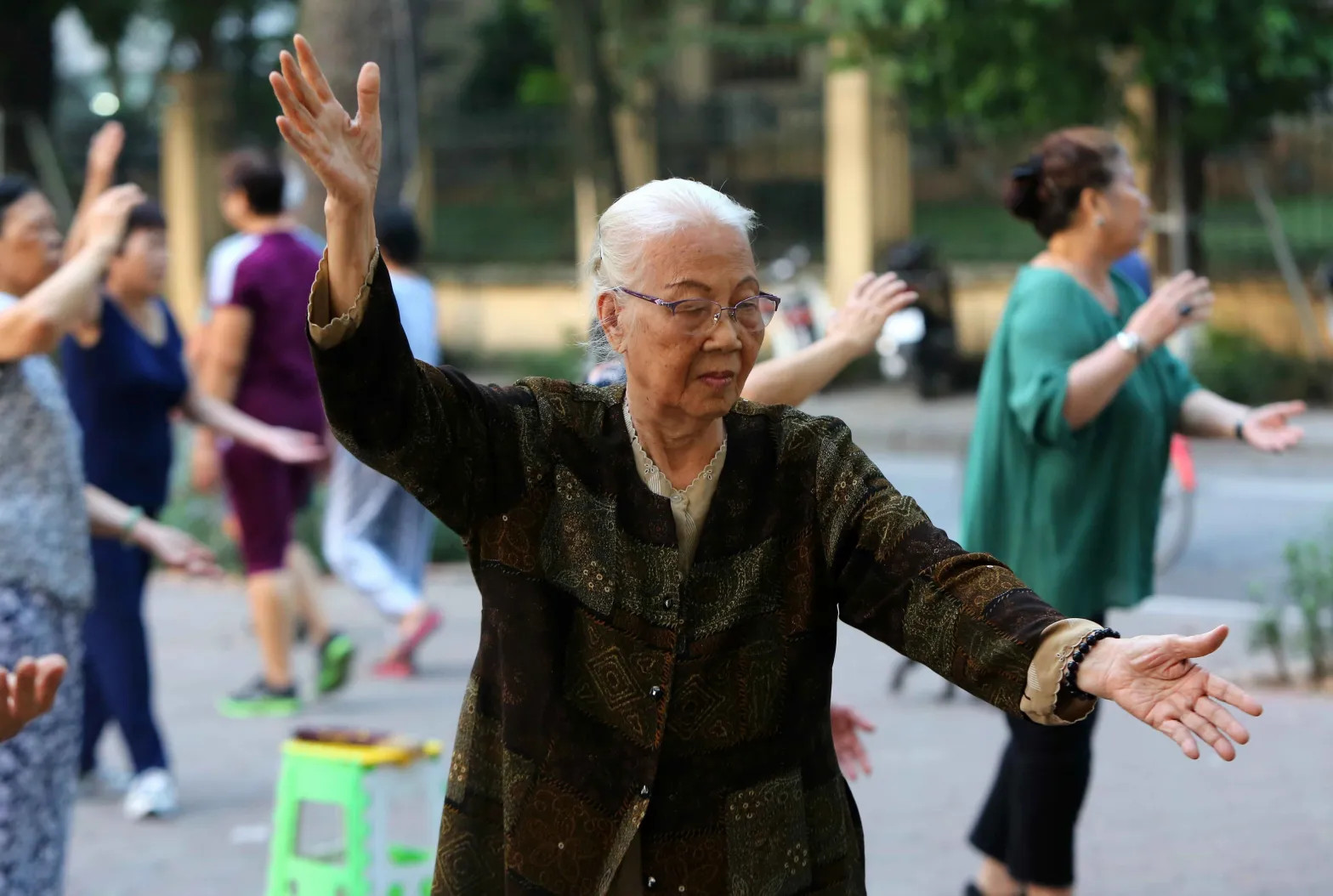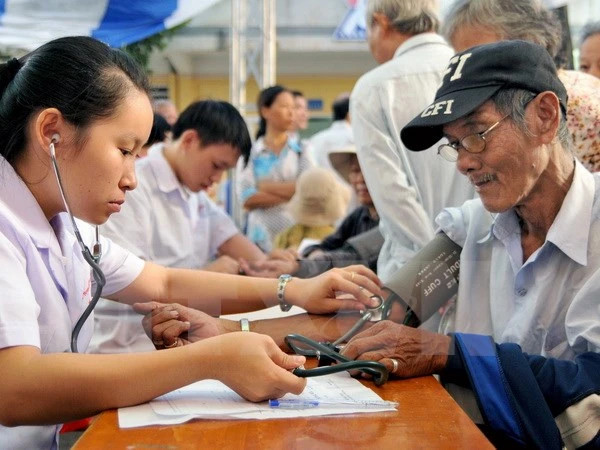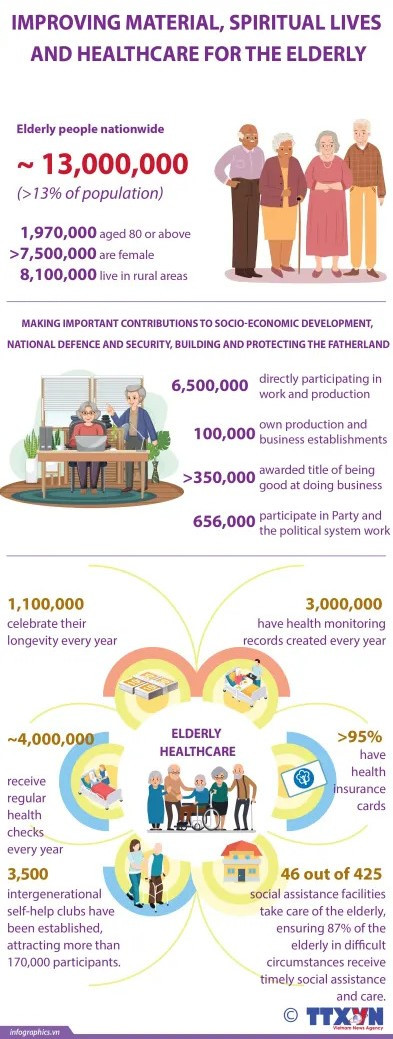

Population aging, especially in developing economies like Vietnam, is creating new pressure and challenges to which the population and development work needs to flexibly respond as there are only 14 years left for Vietnam to prepare for an aged society.
Experts held that Vietnam posts the fastest speed of population aging in the world. Those aged 60 and over accounted for 11.9% of the total population in 2019 and by 2050, this figure is forecast to rise to over 25%. By 2038, the country will enter the “aged population” period, transitioning from an “aging” to an “aged” society.
Risk of labour shortages
Statistics show that in 2023, Vietnam had a population of around 100.3 million, including more than 16 million elderly people. The Ministry of Health forecasts that Vietnam will go into the “aged population” period by 2038, transitioning from an “aging” to an “aged” society, with over 21 million elderly people – equivalent to nearly 20% of the total population. It is noteworthy that the transition from an aging population to an aged population in the country will happen in just over 20 years, while it takes much more time, event almost a century, in developed countries.
The average life expectancy of Vietnamese increased from 68.6 (in 1999) to 73.2 (in 2014), and 74.5 (in 2019). It is forecast to reach 78 in 2030 and 80.4 in 2050. From 2009 to 2021, Vietnam’s aging index increased from 35.5 to 53.1.

In the 1970s – 1980s, Vietnamese women gave birth to many children, at a level higher than the necessary replacement fertility rate (5 – 6 children per woman). However, this trend has been declining and hit its lowest in 2005. Although the average fertility rate has improved, it has not yet reached the necessary fertility rate of 2.1 children per woman. (Photo: VNA)
In the 1970s – 1980s, Vietnamese women gave birth to many children, at a level higher than the necessary replacement fertility rate (5 – 6 children per woman). However, this trend has been declining and hit its lowest in 2005. Although the average fertility rate has improved, it has not yet reached the necessary fertility rate of 2.1 children per woman.
Many experts pointed out that more and more young people in Vietnam now think that marriage and childbirth are inconvenient, troublesome and unnecessary. Therefore, authorities need to develop communication messages and materials about population and development policies to help people gain right awareness in the current context.

A direct consequence of the population aging is the risk of labour shortages. With an increasingly aging population and a declining number of young workers, labour shortages are becoming a worrying issue. Industrial and service sectors will face difficulties in finding enough human resources to sustain and develop, which could lead to a decrease in labour productivity, reduced competitiveness, and negative impact on economic growth, according to experts.

Nguyen Thanh Binh, Chairman of the Vietnam Association of the Elderly, said that the rate of elderly people participating in the workforce has been rising over the past 20 years. In 1999, 19.4% of elderly women and 35% of elderly men worked, and the numbers respectively reached 38% and 46.1% in 2020. During 2010 – 2020, the number of elderly workers grew by an average of 160,000 per year, equivalent to 4% per year, which is twice the overall employment growth rate in the country.
Furthermore, population aging also poses challenges to the healthcare and social security systems. Given the rising proportion of older people, the State needs to develop appropriate policies and infrastructure to ensure the best possible care for the elderly.
Appropriate policies needed
Recognising the inevitable trend of population aging, for the past many years, the Party and the State have always paid attention to developing policies and guidelines, especially the social safety net, to make effective response. For example, under Circular No. 96/2018/TT-BTC, older persons can gain preferential loans from two sources – the Vietnam Bank for Social Policies and the National Employment Fund – to develop livelihoods and improve living standards.

Currently, Vietnam has about 3.1 million elderly people receiving monthly pensions and social insurance allowances. The more elderly people without pensions, the greater pressure on the social security system is created. The higher number of retirees and the longer duration of pension reception require a long-term and capable pension system be formed, which is becoming a challenge to both developed and developing countries. Therefore, it is necessary to create conditions for older persons to further participate in the workforce, thereby contributing to sustainable socio-economic development and adapting to the population aging.

Assoc. Prof. Dr. Ta Minh Tuan, Vice President of the Vietnam Academy of Social Sciences, affirmed that Vietnam should regard population aging as not only a risk but also a substantial chance for sustainable development through older people’s active engagement. With their experience, knowledge, skills and financial resources, the elderly are completely able to become an important factor and resource actively contributing to socio-economic, family and community development.
In addition, it is also necessary to devise policies that encourage women to have children, promote their participation in the workforce, invest in education and training to develop manpower, and create favourable conditions for businesses to attract and retain young workers. At the same time, the use of technology and automation in industries is also a solution. By enhancing automation, Vietnam can reduce its dependence on direct labour, improve labour productivity, and help balance human resources in the industrial and service sectors, Tuan said.

Pham Vu Hoang, Deputy Director of the Population Department under the Ministry of Health, said that population aging brings about both opportunities and challenges.
Regarding opportunities, this process can promote the development of sectors such as insurance, banking, nutrition, tourism, technological innovation, and science – technology application to production or management in the context of labour shortages.
In the face of population aging and labour shortage risk, Vietnam should be proactive and creative in finding out effective solutions. Besides, it needs to learn experiences of other countries that have coped with population aging to develop reality-matching policies to enhance older persons’ self-reliance and independence, especially in terms of finance. The country should also provide opportunities and improve their capacity so that the elderly can become fully involved in the social security, social insurance, and healthcare systems, while ensuring their rights so that they can achieve “successful aging”.
By implementing flexible policies and creating favourable conditions for the elderly to participate in economic and social development, Vietnam can overcome challenges and be prepared for an aged society./. VNA